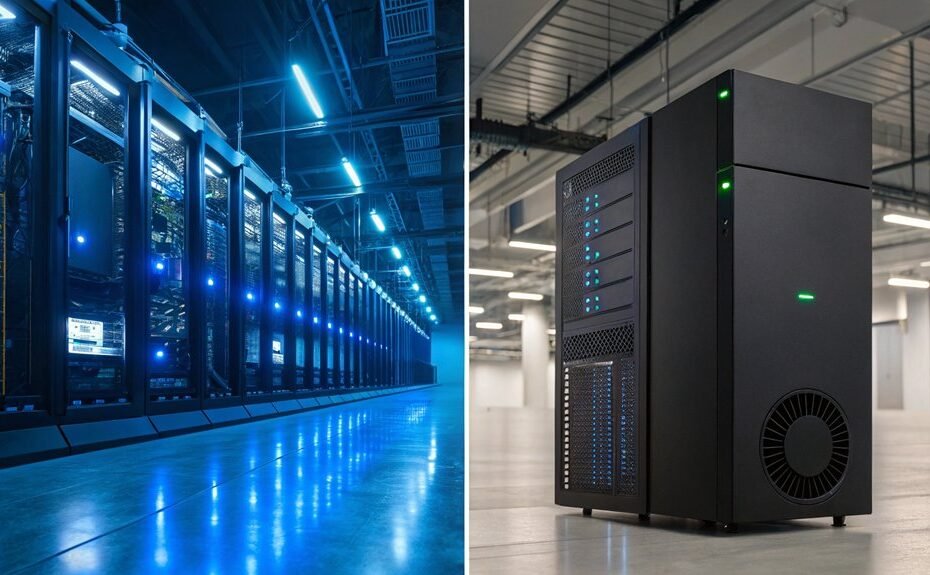AI training and inference represent fundamentally different phases of machine learning development. Training involves teaching models to recognize patterns through intensive computational processing of large datasets, often requiring specialized hardware and significant time investment. Conversely, inference applies these trained models to make real-time predictions on new data, utilizing optimized processes that prioritize speed and efficiency. The distinct computational requirements, data flow patterns, and cost considerations between these phases shape how organizations implement AI solutions. Understanding these differences opens deeper insights into enterprise AI deployment strategies.
While artificial intelligence continues to transform industries worldwide, understanding the distinction between AI training and inference has become more critical for businesses implementing machine learning solutions. The two processes serve fundamentally different purposes, with training focused on teaching AI models to recognize patterns using historical data, while inference applies these trained models to make predictions on new, unseen data in real-world scenarios.
AI training builds the foundation, while inference puts that knowledge to work in real-world applications and decision-making.
The computational requirements and infrastructure needs for these processes differ greatly. Training demands intensive computational resources, typically requiring specialized hardware such as GPUs or TPUs to handle complex matrix operations. This process can extend over hours, days, or weeks, depending on dataset size and available computing power. Many organizations implement continuous learning cycles to maintain model accuracy as data environments evolve. Machine learning algorithms rely heavily on extensive datasets to achieve optimal performance during the training phase.
Organizations must invest in robust data center infrastructure with high computing capacity, reliable storage solutions, and efficient cooling systems to support the training phase.
In contrast, inference operates with lower computational demands but requires optimization for speed and efficiency. This process involves a simple forward pass through the neural network, making it less resource-intensive than training. Nevertheless, inference often needs to occur in real-time or near-real-time, particularly in applications like autonomous vehicles or facial recognition systems.
Organizations typically deploy inference operations at the edge, using specialized hardware accelerators to minimize latency and maintain high throughput.
The data flow patterns likewise distinguish these processes. Training involves multiple passes through large, often labeled datasets, utilizing iterative optimization techniques like backpropagation to improve model accuracy. Inference processes one sample or small batches at a time, focusing on applying the model's learned patterns to generate immediate results.
This difference influences the infrastructure requirements, with training necessitating substantial storage capacity for vast datasets, while inference prioritizes fast data transmission and processing capabilities.
Cost considerations vary between training and inference operations. Training typically involves considerable upfront costs but represents a one-time expense for each model version. Inference, while less computationally intensive, incurs ongoing operational costs as organizations must maintain consistent performance across multiple deployment locations.
The industry increasingly employs optimization techniques such as model quantization and pruning to reduce resource usage during inference, while distributed computing helps accelerate training processes. These technological advances continue to reshape how organizations balance the computational and infrastructure requirements of AI training and inference operations.
Most-Asked Questions FAQ
How Does AI Handle Errors Differently During Training Versus Inference?
AI uses errors during training to adjust and improve model parameters, while in inference, errors are monitored and mitigated through robustness techniques to maintain reliable real-time performance.
What Hardware Specifications Are Recommended for AI Training at Home?
Recommended home AI training hardware includes a workstation CPU, NVIDIA RTX GPU, 64-128GB RAM, NVMe storage, and robust cooling. Linux OS maximizes compatibility with AI frameworks.
Can AI Models Continue Learning While Performing Inference Tasks?
AI models can continue learning during inference through online and incremental learning techniques, adapting to new data while maintaining performance, though this requires careful resource management and monitoring.
How Does Data Preprocessing Differ Between Training and Inference Phases?
Training preprocessing requires extensive cleaning, feature engineering, and standardization of large datasets, while inference preprocessing focuses on quick, streamlined preparation of individual data points for real-time predictions.
What Security Measures Are Necessary During AI Training Versus Inference?
Training requires data encryption, access controls, and validation safeguards, while inference needs model encryption, hardware security, and real-time monitoring to protect against attacks and unauthorized access.
